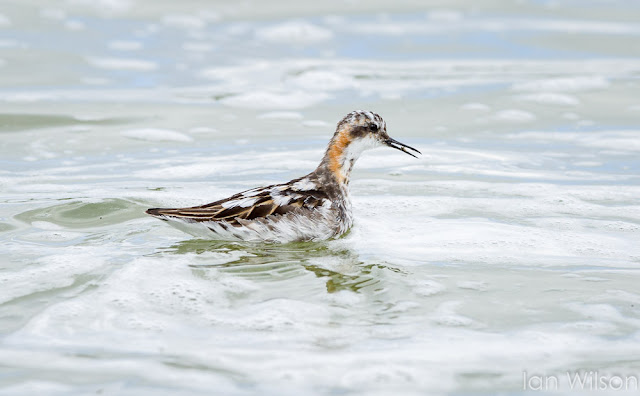Mývatn (literally "midge lake") was formed when the Laxá river became dammed by volcanic activity. Both the lake and the river are rich in insect life, and unsurprisingly this attracts a wide variety of bird life - especially ducks. Harriet and I stopped for a while at the place where the main road crosses the Laxá river in order to see what was around, and the most plentiful bird by far was the Barrow's goldeneye.
There was a lone duckling, battling against the strong current, but I don't know which species it is.
Also in the vicinity was a red-necked phalarope making the most of the plentiful midges, which were absolutely everywhere. If you look closely at the bird-watcher, he is surrounded by a large cloud of the wretched things.
A little further on we visited a lava field where I'd seen my first whimbrels on the previous trip. There were none of my friends-with-the-bent-beaks initially, but the golden plover were certainly in evidence. Their camouflage is almost perfect in the moss and low-growing vegetation which covers the lava field.
Eventually I spotted what I'd been waiting for: whimbrels. I don't know quite why they made such an impression on me before, but it was just the same second time around. They are beautiful birds, and I fell in love with them all over again.
By now it was the middle of the afternoon and we were definitely in need of "a little something", so it was time to head to the café at Mývatn's pickled bird museum. While there I spotted a gyr falcon, but only for a split second so no photograph. Rats! The majority of the other birds on the lake were fairly anonymous ducks, but there was a Slavonian grebe relatively close to the shore.
After a hard day's museum-visiting and bird-watching, we headed for our hotel for a while before supper. The Gamli Bistro, a short walk away, served superb pulled lamb burgers, but it was tipping down by the time we were finished. Our plan had been to revisit Námafjall Hverir, but there didn't seem much point in the pouring rain. I don't think the local horse population was too worried by the weather, however.

























No comments:
Post a Comment